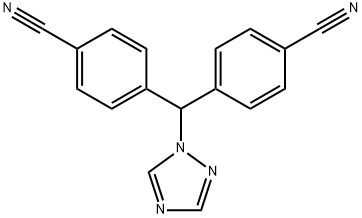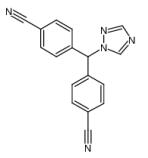Letrozole: pharmacodynamics, pharmacokinetics and mechanism of action
General Description
Letrozole is a potent aromatase inhibitor used primarily for hormone-responsive breast cancer treatment, exhibiting superior inhibitory activity and selectivity. It's orally administered with nearly complete absorption and bioavailability of 99.9%. Its pharmacokinetics involve reaching steady-state plasma concentration in 2-6 weeks, with elimination primarily through CYP450 isoenzymes into an inactive metabolite. The pharmacodynamics are characterized by almost complete inhibition of the aromatase enzyme within a few days, reducing estrogen levels significantly. Despite comprehensive absorption, systemic absorption is extremely low, and there's no evidence of drug accumulation. Adverse effects include nausea, fatigue, hair thinning, hot flashes, bone resorption, and increased cholesterol levels.

Figure 1. Tablet of letrozole
Pharmacodynamics
Letrozole, a highly potent aromatase inhibitor (AI), exhibits superior inhibitory activity compared to other AIs such as aminoglutethimide and anastrozole. Its pharmacodynamics are characterized by nearly complete inhibition of the aromatase enzyme within two to three days at doses of 0.5 to 2.5 mg/day. This high selectivity for aromatase differentiates it from first- and second-generation AIs. Clinical trials have shown letrozole's antitumor activity in post-menopausal women with HR+ breast cancers, even when used alone or in combination with other AIs. Adverse effects include nausea, fatigue, hair thinning, and hot flashes, with more pronounced effects being bone resorption and atherogenic risk due to increased cholesterol levels with prolonged exposure. The pharmacokinetics of letrozole involve instant and complete absorption from the gastrointestinal tract, with a mean absolute bioavailability of 99.9%. It reaches steady-state plasma concentration in 2-6 weeks with daily dosing of 2.5 mg, and its clearance pathway primarily involves biotransformation to an inactive metabolite. 1
Pharmacokinetics
Letrozole is an orally administered non-steroidal drug, characterized by rapid and complete absorption from the gastrointestinal tract. Its bioavailability is approximately 99.9%, and its absorption is not influenced by food consumption. After administration of a single dose of 2.5 mg, maximum plasma concentration is reached within a median time of 2 hours, with steady-state plasma concentrations achieved in 2-6 weeks. The pharmacokinetics of letrozole are not affected by age or patients with renal or hepatic impairment, though severe liver damage may necessitate dose reduction. Upon oral consumption, letrozole is fully utilized within the gastrointestinal tract, avoiding first-pass elimination, and results in nearly 60% binding to plasma proteins, primarily albumin. Extensive distribution in tissues is seen after a single 2.5 mg dose. Multiple doses result in higher plasma concentrations at steady state, impacting the drug's pharmacokinetics. The elimination of letrozole primarily occurs through CYP450 isoenzymes, converting it into an inactive carbinol metabolite. The drug has a half-life of approximately 35.7 ± 18.6 hours, which remains consistent regardless of fed or fast conditions. However, patients with hepatic impairment may see an increased half-life, requiring careful monitoring. Despite its comprehensive absorption and conversion to an inactive form for elimination, systemic absorption is extremely low, and no evidence of drug accumulation has been reported. 2
Mechanism of action
Letrozole, primarily used in the treatment of hormone-responsive breast cancer, functions as a potent inhibitor of aromatase, an enzyme that catalyzes the biosynthesis of estrogen from androgens. The mechanism of action involves Letrozole competitively binding to the heme of the cytochrome P450 subunit (CYP450) of the aromatase enzyme. This binding blocks the conversion of C19 androgens into C18 estrogens. As aromatase is chiefly expressed in ovaries and declines with age, its inhibition by Letrozole significantly reduces estrogen levels in the body. However, it's important to note that estrogen production continues in peripheral tissues, including breasts, which is why Letrozole is particularly effective in treating breast cancer. In summary, Letrozole's primary function is to inhibit estrogen production by blocking the activity of the aromatase enzyme, thereby reducing the growth of hormone-responsive cancer cells. 3
Reference
1. Dellapasqua S, Colleoni M. Letrozole. Expert Opin Drug Metab Toxicol. 2010 Feb;6(2):251-259.
2. Pfister CU, Martoni A, Zamagni C, Lelli G, De Braud F, Souppart C, Duval M, Hornberger U. Effect of age and single versus multiple dose pharmacokinetics of letrozole (Femara) in breast cancer patients. Biopharm Drug Dispos. 2001 Jul;22(5):191-197.
3. Thierry A, Protocol S, Phase II Study of Letrozole (Femara) Plus Imatinib Mesylate (Gleevec) for Post-menopausal Patients with ER and/or PR Positive Metastatic Breast Cancer 2003-0384, 2007.
Related articles And Qustion
See also
Lastest Price from Letrozole manufacturers

US $0.00/Box2025-09-26
- CAS:
- 112809-51-5
- Min. Order:
- 1Box
- Purity:
- 0.99
- Supply Ability:
- 0 tons

US $10.00-7.00/VIAL2025-07-25
- CAS:
- 112809-51-5
- Min. Order:
- 10VIAL
- Purity:
- 99.9
- Supply Ability:
- 20000




